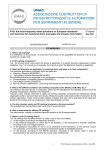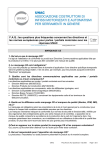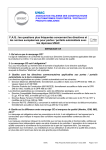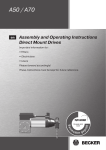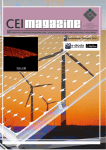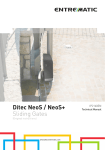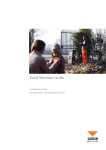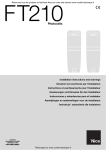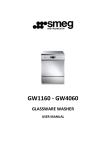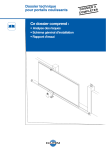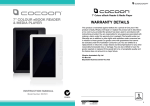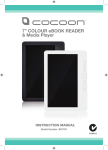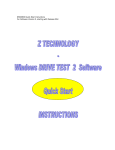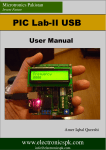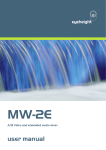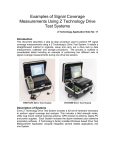Download FAQ: the most frequently asked questions on European
Transcript
FAQ: the most frequently asked questions on European standards and directives for motorised doors and gates and answers from UNAC www.associazioneunac.it 3rd Edition May 2005 [email protected] CE MARKING 1- What is CE marking? It is certification, by the producer, of conformity of the product to the applicable EC directives. It is not to be considered a quality mark. 2- Is CE marking compulsory? Yes - for products which come within the sphere of application of a specific directive implemented in Italian legislation. Thus it is compulsory, for example, for products to which the Machinery Directive is applicable. 3- Which EC directives are applicable to motorised doors and gates or to their components? The directives applicable to motorised doors and gates are: Machinery Directive (89/392/EEC): implemented in Italy with Presidential Decree no. 459 of 1996, in force from 21 September 1996; Construction Products Directive (89/106/EEC): implemented in Italy with Presidential Decree no. 246 of 1993, amended by Presidential Decree no. 499 of 1997. The following directives are applicable to the components, according to the various types: Electromagnetic Compatibility Directive (89/336/EEC): implemented in Italy with Decree Law no. 476 of 1992, amended by Decree Law no. 615 of 1996; Low Voltage Directive (73/23/EEC): implemented in Italy with Law no. 791 of 1977, amended by Decree Law no. 626 of 1996; R&TTE Directive (1999/5/EEC): concerning radio equipment and telecommunications terminals; implemented in Italy with Decree Law no. 269 of 9 May 2001. 4- What is the difference between CE marking and quality marks (Nemko, ICIM, IMQ, etc.)? CE marking is laid down by law, is compulsory, affixed by the manufacturer and indicates observance of the essential requirements contained in the directives. Voluntary marks indicate conformity to safety and working standards, ascertained by independent outside organisations after a series of tests and checks. Affixing the quality mark entails control of production by the outside organisation. These marks provide retailers, installers and users with a guarantee of the safety and quality of the products and are recognised in major industrialised countries. 5- Can the voluntary marks and CE marking be placed on the same product? Yes, provided they are fully distinct from each other to avoid confusion. 6- Who is responsible for affixing CE marking? The manufacturer, importer or whoever places the product on the European market. 7- Where is the CE marking found? The CE marking must be affixed where it is visible, easy to read and indelible. on the machine according to the Machinery Directive (cf. Presidential Decree no. 459 of 1996); on the electrical equipment or, where this is not possible, on the precautions or warranty certificate, according to the Low Voltage Directive (cf. Decree Law no. 626 of 1996); -1- FAQ (Frequently Asked Questions) UNAC – May 2005 on the appliance, instructions for use or, as an alternative to the instructions, on the warranty coupon and, optionally, on the packing, according to the Electromagnetic Compatibility Directive (cf. Decree Law no. 615 of 1996); on the product, according to the R&TTE Directive. According to the various cases it must be accompanied by the symbol (!) and/or the number of the notified body. 8- If a product comes under several directives must it have several CE markings? No, one single CE marking is sufficient for indicating conformity of the product to all the applicable directives. 9- Are retailers and/or installers responsible for the CE marking not being affixed on products which they purchase and/or sell? Yes. Before purchasing a product the retailers and/or installers must check that the CE marking is there. Otherwise national legislation lays down specific penalties. MACHINERY DIRECTIVE 10- Who is the manufacturer of the motorised door/gate? The person who supplies the motorised door/gate or who “motorises” an existing manual door/gate. In all cases the manufacturer must affix the CE marking on the motorised door/gate, assuming responsibility for the manufacture of the “machine”. 11- When did Presidential Decree no. 459/96 (implementation of the Machinery Directive) come into force in Italy? Presidential Decree no. 459 of 24 July 1996 made application in Italy of the Machinery Directive 89/392 EEC and subsequent amendments compulsory. The Decree, published in the ordinary supplement to the Official Gazette no. 209 of 6 September 1996, came into force on 21 September 1996. 12- What is the responsibility of those who carry out work on a system brought into service before the coming into force of Presidential Decree no. 459/96? According to Presidential Decree no. 459/96, routine and unscheduled maintenance does not entail application of the Machinery Directive to a product already in operation prior to 21 September 1996. Vice versa, if operations which are not part of routine and unscheduled maintenance are carried out, the work is seen as construction of a new machine and therefore Presidential Decree no. 459/96 should be applied. A recent Italian law (no. 62 of 18 April 2005), that amends Decree Law no. 626 of 19 September 1994 and is applicable in workplaces, basically lays down that, by 11 November 2005, employers must align all working equipment with the minimum safety requirements. See also FAQ nos. 13, 14 and 64. 13- What should be done if changes have to be made to a system brought into service after the coming into force of Presidential Decree no. 459/96 and which does not observe the Machinery Directive? The owner of the system has to be informed of the installer’s and his own civil and criminal liability arising from failure to observe the law. Before carrying out any work on the system, it has to be aligned with the essential safety requirements laid down by law. 14- Is the maintenance technician who performs repairs on a component without CE marking bound to affix it? It is not the duty of the maintenance operative to affix the CE marking on the components and the finished door/gate. When necessary, the components must be replaced with others with identical functions and specifications. The use of different components could be seen as a modification to the machine and therefore requires its alignment with the laws/standards in force at the time of the modification. The only exception regards the radio controls operating at frequencies currently assigned to other services. In this case it is necessary to replace the products with others that use permitted frequencies. See also FAQ no. 62. 15- If, for various reasons, the client does not want to install the safety devices, what should be done? UNAC recommends refusing the job after having informed the client in full of the risks incurred. 16- Is there the possibility of obtaining a discharge document for installation or work on a system not complying with standards? There is no possibility of obtaining any discharge pursuant to both Presidential Decree no. 459/96 and Law no. 46/90; Art. 7: “Installer firms are bound to produce systems to standard, using for this purpose materials also manufactured to standard”. -2- FAQ (Frequently Asked Questions) UNAC – May 2005 17- Must each machine have a plate with the CE marking? What must be written on the plate? Yes, as Attachment I to Presidential Decree no. 459/96 states: "each machine must bear, legibly and indelibly, at least the following information: name and address of manufacturer, CE marking, designation of series or type, possibly the serial number, year of manufacture". 18- Which obligations arise from application of the Machinery Directive? In order to assist the installer in fulfilling the obligations arising from application of the Machinery Directory to motorised doors and gates, UNAC has drafted “Guidelines for the installation of motorised doors and gates in accordance with Machinery Directive 98/37/EEC and the standards EN 12453 and EN 12445”, containing a guided outline for evaluating risks. The document, produced by experts from UNAC firms, was devised to facilitate the task of installers and is a tool aimed at informing those in the trade of the content of the Machinery Directive and the new European standards. 19- Do the risks listed in the UNAC guidelines correspond to those stated in the Machinery Directive? The risks considered in the UNAC guidelines correspond to those stated in the European standards EN 12453 and EN 12445 regarding safety in the use of motorised gates and doors. Although this guide was drafted with the utmost care by technical staff from UNAC firms, it might not include all the risks which may occur in each particular installation. Therefore the manufacturer of the “machine” is still responsible for completing or aligning analysis of the risks indicated in the guidelines. 20- How must the user be informed of the residual risks of the machine? Accurate information of the residual risks existing in the “machine” must be provided via a document to be consigned to the user (user manual, proof book, etc.). 21- Can there be several risks for the same area indicated in the assembly drawings of the doors and gates included in the UNAC guidelines? How must these areas be protected? Yes, there may be several risks in the same area, which should be protected individually or as a whole. The indications contained in the UNAC guidelines can be of effective assistance in locating them. 22- Where can the standards mentioned in the UNAC guidelines be found? All the standards can be consulted free of charge or purchased from the sales outlets of UNI, the Italian standards body, (tel. 02 70024200 – www.uni.com) and those of the CEI, Italian electrotechnical committee, (tel. 02 210061 – www.ceiweb.it). 23- Who should be issued with the technical file? The technical file has to be drawn up and kept by the manufacturer of the “machine” for at least 10 years from the date of manufacture (date of installation of the motorised door or gate) and should be made available to the relevant authorities when required. 24- What should be the qualification of those who issue the declaration of conformity pursuant to the Machinery Directive? The declaration of conformity is the formal assumption of responsibility by the manufacturer of the conformity of the machine to the requirements laid down by the applicable directives. It must be signed by the legal representative of the company or by a person with power of attorney from a notary public for signing the declaration. 25- Is it obligatory to consign a copy of the Declaration of Conformity of the motorised door/gate to the owner? Yes! The declaration should be kept in the technical file and a copy must be given to the owner. 26- If someone purchases from a supermarket a kit for automating a gate, to be installed for private use, must he or she draft the Technical File and declaration of conformity and affix the CE marking on the gate? Yes, pursuant to the Machinery Directive. This does not include automation systems for garage doors for domestic use in individual homes and with non-automatic control if the producer of the automation kit declares that it meets the requirements of the standard EN 60335-2-95 in full. CONSTRUCTION PRODUCTS DIRECTIVE 27- Are the procedures for certifying conformity to the Construction Products Directive applicable to motorised doors and gates? The standard EN13241-1 (harmonised standard according to the Construction Products Directive and Machinery Directive) was published in the Official Journal of the European Union C 67/7 of 17 March 2004. 1 May 2004 marked the start of the transition period during which application was voluntary. Application has been compulsory from 1 May 2005. -3- FAQ (Frequently Asked Questions) UNAC – May 2005 28– To which products does the standard EN13241-1 apply? It applies to all types of doors and gates, both manual and motorised, used for the transit of persons and vehicles, in industrial, commercial and residential environments. The term “door” refers to all types of doors and gates, up-and-over or sectional doors, gates, road barriers, shutters etc. The exclusions cover manual pedestrian doors smaller than 6.25m2, motorised pedestrian doors (dealt with by prEN 12650-1); fire doors (dealt with by prEN 13241-2) and barriers used solely for vehicle transit. 29– What are the main requirements of the standard EN13241-1? The standard specifies the safety and performance requirements of the doors and gates, it lays down that the producer must declare these specifications and it requires the performance of tests to demonstrate these specifications (some with the intervention of a notified body). It also lays down that the producer must control production to ensure that the performances measured on the test specimens are maintained in current production. 30– Does the standard EN13241-1 apply to automatic devices? No, none of the requirements applies directly to automatic devices. However in some cases they are directly involved. 31– What is the notified body? The standard EN13241-1 provides for the procedures for certifying the conformity of industrial, commercial and garage doors and gates to be performed according to “system 3”, as defined in the Construction Products Directive. System 3 requires a “notified body” for the initial type tests of the product. The notified body is a third party, typically a test laboratory, that has obtained (in Italy) from the “Ministry for Production” notification and qualification for EC certification pursuant to directive 89/106/EEC (Construction Products Directive). RELATIONS WITH CLIENT/USER 32- If an accident occurs for reasons which do not depend on the manufacturer, is the latter no longer responsible? Is insurance provided for the manufacturer? The manufacturer is always responsible, according to the provisions of current laws, for own work. Otherwise the blame or omission of the manufacturer can only be ascertained at the end of the inquiry into the accident. Clearly, if no fault is ascertained, there will be no consequences for the manufacturer. The manufacturer can stipulate a contract which transfers to an insurance company the risks arising from civil law consequences (civil liability) of accidents for which he is to blame. 33- For how long is the manufacturer responsible for the system? The contract of works, which governs relations between the installer/maintenance technician and the client, provides, in favour of the latter, action for non-conformity and defects which is set at two years from the date of consignment of the work (Art. 1667 Italian Civil Code). As regards liability for damages caused by defective products, the manufacturer is liable for a period of 10 years from the date of manufacture (date of installation of the door/gate). 34- Is maintenance compulsory? Who is responsible for the failure to carry out maintenance? Maintenance of machinery, including therefore automatic gates and doors, has to be carried out according to the indications by the manufacturer in the relevant maintenance schedule. Maintenance is to be performed by the owner who becomes liable for accidents and damage due to faulty or lack of maintenance. UNAC recommends the provision and implementation of a maintenance schedule, according to the instructions in the maintenance manual and the indications of the standard EN 12635. In the systems of buildings where Decree Law no. 626/94 applies, maintenance of machinery is compulsory. See also FAQ no. 64. 35- Should the system be produced by several persons, who is the manufacturer and hence responsible for the system? There must in all cases be a “project manager” who takes on the task of issuing the EC declaration of conformity and is therefore responsible for the automatic gate. EUROPEAN STANDARDS EN 12453 – EN 12445 AND UNAC GUIDES 36- Is observance of the European standards EN 12453 – EN 12445 compulsory? As with most standards, they are not strictly compulsory. UNAC recommends application of EN 12453 and EN 12445 in that they allow a declaration of presumed conformity to the European Directives. Otherwise observance of the requirements of the Directives has to be demonstrated. -4- FAQ (Frequently Asked Questions) UNAC – May 2005 37- Are there penalties for those who do not observe the standard? There are no penalties for those do not observe the voluntary standards, but instead for those who do not observe the European Directives. 38- If safety of the motorised door or gate is achieved by restricting the operating forces, should the forces be measured in each installation? Yes. It is necessary to check, on each system, the actual operating forces (linked to the specific features of the installation itself: weight, speed, friction, regulations, safety devices, etc.). 39– Is it always necessary to measure the forces? No. It is not necessary in the case of installations actuated by hold-to-run control or with type E safety devices that prevent contact with the moving door in all situations. 40 - Can the manufacturer of the drive units carry out the force tests on the sample gate in the most disadvantageous working conditions and give the installer instructions on how to set the parameters, for example in the installation manuals, exempting him from measuring the operating forces of the gate? No, since it is not possible to demonstrate that the results of the relevant tests are repeatable in situ. See also FAQ no. 38. 41- How is the instrument supported during force measurements? The forces must be measured, in the various measurement points, so as not to affect the test results. Rigid extensions must therefore be used with contact diameter of at least 80 mm, positioned rigidly and against the movement of the leaf. 42– Is software required for the instrument that measures impact force? The standard EN12445 lays down that the forces measuring instrument must be equipped with a plotter or XY recorder. The standard EN 12453, that sets the limits, also lays down somewhat detailed criteria of acceptability; for example peaks after the first one are admissible provided they are of decreasing value. All this requires a check on the graph of the forces. At present, to our knowledge, no instrument is capable of displaying the graph directly. 43– Where can the forces measuring instrument be purchased? The information available to UNAC indicates that it is currently possible to purchase the instrument required by European standards from (in alphabetical order): • • • • Drive Test GmbH (www.drivetest.de) GET Industrieelektronik GmbH (www.gte.de) Microtronics S.r.l. (www.microtronics.it) Normagate S.r.l. (www.normagate.com). UNAC does not guarantee the quality of the producers and relevant products indicated. 44- Is the flashing light required by the European standards? The standards relating to the safe use of motorised gates and doors do not indicate it as obligatory, but instead refer its use to evaluation of the risks in installation. UNAC however recommends that it be used. 45- Is the emergency stop required by European standards? No. The standard EN12553, in paragraph 5.2.2., where it refers to the standard EN60294-1, even tends to advise against it, declaring it to be “inapplicable”. There may however be areas or situations of use in which it is required. In this case great care should be taken that the emergency stop does not reduce the safety of the installation as it disables all the safety devices of the machine when actuated. 46– Does the Low Voltage Directive have to be applied when installing an automatic gate, if the whole electrical system (motors, sensitive edges, photocells, flashing light, etc.) has a very low voltage (24V), and the manufacturer of the automatic device has supplied a plug to be inserted in the socket for power supply from the mains? Yes, for the part relating to the socket, if the voltage of this socket is, for example, 230V. 47- If considered unlikely, infrequent and not dangerous, is it possible not to protect against some risks (see for example risks [D] and [F] indicated in UNAC Guide no. 1 for sliding gates)? Yes. However users of the automatic door/gate must in any case be informed in writing in the user manual (or proof book) and, where possible, the appropriate signs attached. -5- FAQ (Frequently Asked Questions) UNAC – May 2005 48- What are the residual risks? The residual risks are those which, after analysis of the product (machine), are evaluated as: unlikely, infrequent and not dangerous, in relation to operation and the costs required for their elimination or protection. 49- Does the sensitive edge for restricting the operating forces of the sliding gate have to be installed on the mobile leaf or can it be installed on the fixed closure jamb? The purpose of the sensitive edge is to reduce the force of impact between the mobile leaf and any other object, which could also be a car that has stopped. Consequently the edge has to be fitted on the mobile leaf. Any other edges on the fixed parts may be useful for reducing other risks. 50- Can the hold-to-run control also be actuated with TV camera vision? No, as the TV camera cannot be considered as being near the door/gate. 51- Is attachment of the product identification plate to the gate compulsory? Yes, as the Machinery Directive requires it. 52- If the emergency stop device is actuated, is it possible to control the door in hold-to-run mode? If a safety device which stops the door/gate is actuated, is it possible to control the door/gate in holdto-run mode? No, in the case of actuation of the emergency stop device. It should however be checked that installation of an emergency device does not reduce the safety of the door/gate. Yes, in the case of tripping of the safety device, but make sure that all the hold-to-run conditions are observed as specified in the standard EN 12453 (including the position of the controls in relation to the view of the door/gate). 53– Is automatic restarting possible after a power cut? An intentional reset action is not necessary after a stoppage if efficiency of all the protection devices for ensuring safety has been ascertained. 54- How many photocells should be installed and where for the gate to comply with standards? It should be pointed out that the photocells (type D device) are not always compulsory, depending on the “type of actuation of the door/gate” according to the provisions of schedule 1 of the standard EN 12453. According to this schedule, photocells are always used in combination with the type C device (forces restricting means). All this being so, in order to establish the quantity of photocells, the existing risks have to be analysed and an evaluation carried out as to whether a photocell reduces the risk. In the event of a photocell being installed and where the gate opens onto a public area, even if not specified by the standards, it is usually preferable to install it on the outer side (the one in the public area). Finally, in order to evaluate the position, it has to be considered that, for the working test, the 700x300x200 mm parallelepipeds are used to obscure the “ray”. 55- Do the photocells and the safety edges sold separately from the drive units require the EC declaration of conformity for safety components (pursuant to the Machinery Directive Annexe II-C)? With which standards must they comply? The sensitive edges used to limit the impact forces of the motorised door/gate must observe the requirements of the standard EN 12978 and must have the EC declaration pursuant to the Machinery Directive according to annexe II-C. The photocells used for sensing persons are not safety devices and do not come within annexe IV of the Machinery Directive. They should be used in addition to the devices for limiting working forces and must observe the requirements of the standard EN 12453. 56- Which features must the photocells for automatic doors/gates have? Are “self-aligning” photocells allowed? The photocells (including those referred to as “self-aligning”), which have a presence sensing function in addition to limitation of the working forces of the leaf, must fulfil the requirements and pass the tests indicated in the standards EN 12453 for this type of device (type D). 57- Can photocells, not being safety devices, not be “fault safe”? No minimum category for photocells (type D presence sensing device) is laid down in relation to fault safety. However a periodical check on the device is laid down at intervals of less than 6 months. 58- Do photocells with a reflector comply with standards? -6- FAQ (Frequently Asked Questions) UNAC – May 2005 Some devices available on the market use polarised reflectors and are therefore able to pass the test laid down by the standard EN 12445 with the 70x30x20 cm parallelepiped that has a reflecting surface. 59- Can infrared radar be considered a safety device? The standards do not lay down which technology to use for the safety devices. They must in any case observe the requirements defined by the standards on the basis of the function performed by the device (type C, D or E). 60- Do radio-controlled sensitive edges comply with standards? If the sensitive edge is used as a type C device, it has to be checked that the category declared corresponds to the one required. See also FAQ nos. 55 and 59. 61- Are periodical checks foreseen on installations of automatic doors/gates by public authorities? In all areas subject to Decree Law no. 626/94 the competent authorities have the power to carry out checks. In general, in all areas, in cases of justified requests, the competent authorities have however the power to intervene. 62- What should the installer do when called to repair an existing gate brought into service prior to the coming into force of the European standards? He can carry out the repairs without the obligation of aligning the system with the new standards. It is however advisable to propose to the owner of the motorised gate alignment of the system with the latest European standards. Should the system not fulfil the safety and health requirements laid down by the Machinery Directive according to the state of the art referred to the date of installation of the gate, the repairs can only be carried out if the system is aligned with the Machinery Directive and standards currently in force. See also FAQ nos. 12, 13 and 14. 63- What should be done for maintenance of old systems in which 300MHz remote controls are still used? Use of the old 300MHz remote controls has been disallowed for several years. Even if still working, they must be replaced with products that comply with the new legal provisions. 64- If there is no maintenance contract, who is responsible for the automatic door/gate? The manufacturer of the motorised gate is responsible for conformity of the product to the European directives. Those who perform maintenance are in charge of their work as laid down in the maintenance contract and according to the instructions of the manufacturer. If, contrary to what is laid down by the manufacturer, maintenance is not carried out, the owner and/or the operator of the gate is answerable for any damage caused by malfunctioning (provided that the event cannot be traced to an original or installation defect). -7- FAQ (Frequently Asked Questions) UNAC – May 2005







